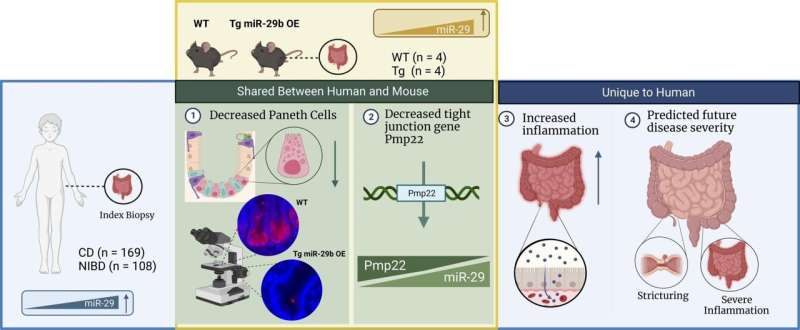This article has been reviewed according to Science X's editorial process and policies. Editors have highlighted the following attributes while ensuring the content's credibility:
fact-checked
trusted source
proofread
Study finds microRNA can predict severe Crohn's disease in children

When comparing intestinal samples of children with Crohn's disease and healthy children, one molecule stands out: the microRNA (miRNA) miR-29, which shows significant differences between the two groups, researchers found.
This new finding will allow scientists to predict disease severity for patients and may offer a new therapeutic target. The research is published in the journal JCI Insight.
Crohn's disease is an inflammatory bowel disease that causes pain and severe diarrhea and can lead to malnutrition and weight loss. While medications can help relieve symptoms, there is no cure, and remission is difficult to achieve in pediatric patients.
"Pediatric Crohn's is on the rise in terms of prevalence across the world, and children often suffer a more devastating and severe form of the disease," said Praveen Sethupathy, professor of Physiological Genomics and chair of the Department of Biomedical Sciences in the College of Veterinary Medicine, who led the study—the result of a long-standing collaboration with researchers at the University of North Carolina, Chapel Hill.
miRNAs, small molecules that regulate many biological functions, including gut physiology, are known to play an integral role in adult Crohn's disease—but very few studies have looked at them in children.
Sethupathy's study, which analyzes data from more than 250 children, draws from the largest-ever miRNA pediatric Crohn's disease sample. "The large sample size offers the most reliable picture to date of how microRNAs are altered in this disease," Sethupathy said. "Although the technology of small RNA-sequencing is not new, it has never been performed before on so many pediatric Crohn's disease tissue samples."
Looking at all the miRNA found in gut samples in healthy and sick children, researchers were struck by one particular molecule called miR-29.
This specific miRNA was too plentiful in children with Crohn's disease, compared to healthy ones. The same is not observed in adults, making abnormally high miR-29 levels a distinguishing feature of pediatric Crohn's disease.
"Although there are many similarities in the microRNAs that are perturbed between adult and pediatric Crohn's, it looks as though elevated miR-29 is a marker only of the pediatric version of the disease," said Alexandria Shumway, first author of the study and a doctoral student in the field of genetics, genomics, and development.
The team also found that higher levels of miR-29 correlated with the levels of inflammation—and therefore the disease severity—and the loss of Paneth cells, which help protect the gut against invasion of harmful bacteria. "We were fascinated by how this single microRNA, miR-29, exerts such strong control over Paneth cells in the gut," said Mike Shanahan, senior research associate in the Sethupathy lab and a co-first author on the study.
Confirming this finding in mice, the researchers observed that when miR-29 increased, Paneth cells were almost completely lost. "It was really striking to see that in such a very specific and important gut cell type," Sethupathy said.
Though the connection between Paneth cells and Crohn's disease is clear in the study from Sethupathy and his collaborators, the precise mechanism is still unknown. "This was an interesting and important finding. So, one important next step will be to unravel this mechanism," he said.
A first of its kind, this study also highlights other miRNA changes that can be studied to discover new and effective therapeutic avenues for pediatric and adult Crohn's disease. Among those, one in particular, miR-375, was already associated with the regulation of inflammation. Sethupathy believes this study will be an important turning point and will help the research community identify key regulators of the disease well beyond miR-29.
More information: Alexandria J. Shumway et al, Aberrant miR-29 is a predictive feature of severe phenotypes in pediatric Crohn's disease, JCI Insight (2024). DOI: 10.1172/jci.insight.168800















